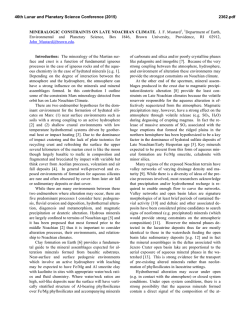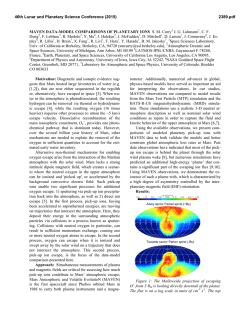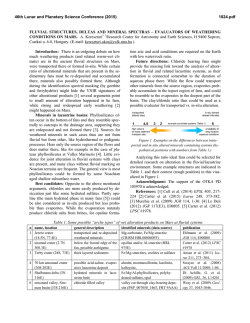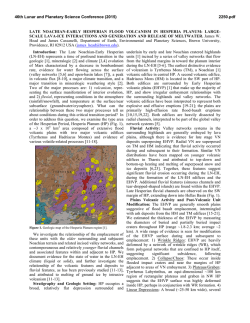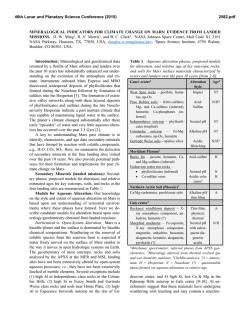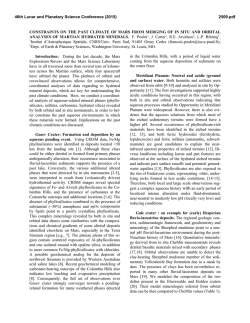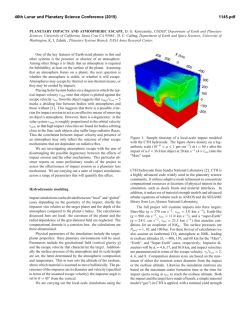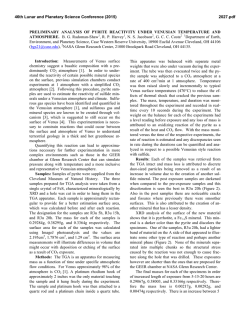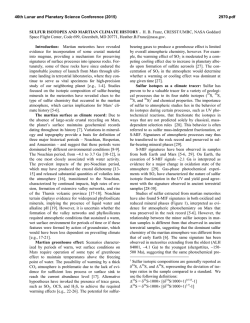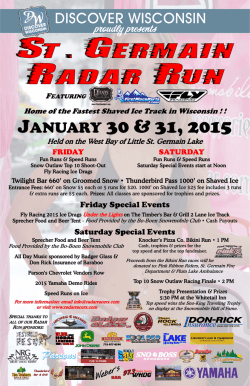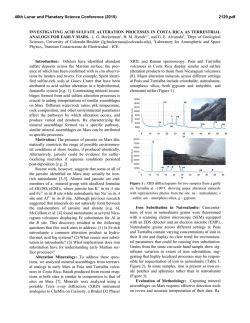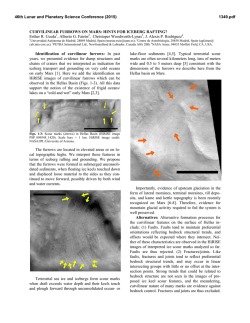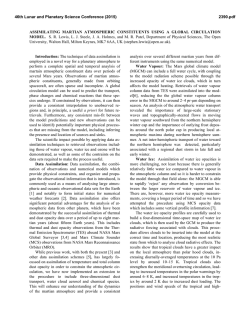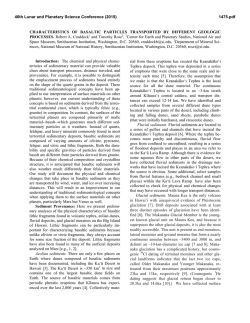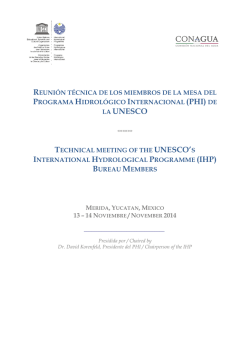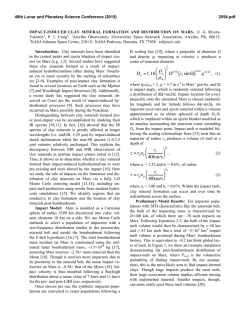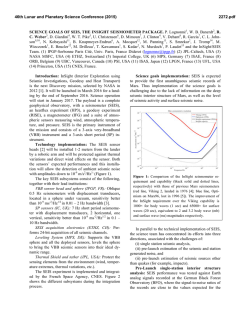
tracing the evolution of the ancient martian atmosphere and climate
46th Lunar and Planetary Science Conference (2015) 2176.pdf TRACING THE EVOLUTION OF THE ANCIENT MARTIAN ATMOSPHERE AND CLIMATE: A SYNTHESIS OF OUTSTANDING GEOMORPHOLOGICAL AND MINERALOGICAL QUESTIONS. J. W. Head1, R. Wordsworth2, F. Forget3, J.-B. Madeleine3, and I. Halevy4, 1Brown Univ., Providence, RI 02912 USA ([email protected]), 2Harvard University, Cambridge MA 02138 USA, 3Lab. de Météorolog Dynamique du CNRS, Université Paris 6, Paris, France, 4Weizmann Inst. Sci., Rehovot, Israel. Introduction: Determining the nature of the early martian atmosphere and climate, and their evolution, involves some of the most interesting and enigmatic questions in planetary science. In a sense, we are “crime scene investigators”, presented with the results of the “deed”, but not knowing how the “deed was done.” Unknown are the exact starting conditions, the history and variability of solar luminosity, and the nature of the initial atmospheric and climate processes that ultimately created the rich >4 billion year geological record that we see today. Convolved in this quest is the fundamental enigma of the origin of life: What is the range of conditions under which life can originate and survive? Progress in solving these basic problems requires a deep understanding of the principles of individual disciplines, combined with significant lateral communication and collaboration so that fundamental assumptions from different disciplines can be tested and verified. Interdisciplinary discussion is the key to forward progress on determining the nature and evolution of the ancient Mars atmosphere and climate. Here we outline a series of fundamental observations and questions designed to encourage interdisciplinary discussion and forward progress on these issues. In our research, we look to the present atmosphere and climate to confidently define a baseline, and we work backward in time to document changes in the geologic record that signal changes in the nature of the atmosphere and climate. Our goal is to determine the nature of the Late Noachian climate, and to use this vantage point to peer back into the earlier Noachian and the pre-Noachian eras of the history of Mars. We focus on the major geological (geomorphological) and mineralogical themes (and related context) and we offer questions that we hope will lead to further informed interdisciplinary discussion, and ultimately, to answers. To maximize discussion, we focus on questions at the expense of literature citations. Late Noachian (LN) Fundamental Questions: State of the LN Atmosphere: What was the nature of ambient LN atmosphere? What were its composition, density and pressure? Was it characterized by stability and occasional perturbations, or by extreme transience and variability? What are the plausible sources of atmospheric components that can cause changes in surface temperatures (greenhouse gases, dust, ash, etc.) and what is the duration of these effects? Under what conditions do surfaceatmosphere thermal coupling, and the adiabatic cooling effect, occur? Are such conditions transient or evolutionary? What is the relationship between altitude- dependent cooling effects and latitude-dependent cooling effects, and how does this vary with time? Climate Evolution Drivers: What was the nature of LN spin-axis orbital parameters? Was the LN characterized by variations similar to those in the Amazonian, or was there more, or less, variability? What was the ambient solar luminosity and its variability? Abundance of Water: What was the total water budget of LN Mars? Was it similar to that of today or significantly greater? How was it partitioned between the atmosphere, the surface, the cryosphere, the groundwater system, and mineral alteration processes? How did this change with time? What processes led to sequestration of water (burial, mineralogical alteration) or loss of water to space with time? Hydrological System and Cycle: Was the LN characterized by a global cryosphere and a horizontally stratified hydrological system? If so, how thick was the cryosphere and how much was occupied by ice-cement? If not, how were areas of vertical hydrological system integration maintained and for how long? What is the nature and evolution of the deep groundwater system? Was the distribution of LN surface water driven by latitude cooling effects or altitude cooling effects or both? What were the rates of exchange among the elements of the hydrological system under each case? How did this change with time? Volcanism: What was the peak LN volcanic flux, and the mean? Was LN-EH volcanism a specific evolutionary phase, or simply the decay of early crustal formation processes and their aftermath? What was the proportion of intrusive to extrusive activity? What was the volatile content of magmas and how did this change with time? How did the emplacement of high-effusion rate volcanic deposits alter the atmosphere and for how long? What was the effect of the emplacement of regional flood basalts on the LN cryosphere, and on regional snow and ice deposits? How significant a factor is magmatic heating in altering the cryosphere and inducing vertical hydrological integration? Impact Cratering: What is the influence of LN impact events on the atmosphere and how does this vary with size? Why are LN impact craters so highly degraded, despite the low erosion rates typical of the Noachian? What was the initial state of impact craters on LN Mars? Did any LN impact craters form in regional ice deposits, and if so, what was their morphology? Can the Amazonian glacial record of impacts formed in, and modified by, ice be used to make predictions? What size impact significantly modified the thermal structure of the LN 46th Lunar and Planetary Science Conference (2015) crust, what were the hydrothermal effects, and how long did they persist? If a global cyrosphere existed, how effective were LN impact events in providing vertical hydrological integration and for how long? Is the LN atmosphere and climate the aftermath product of the PLN period of higher impact flux? Pluvial and Nivial Activity: When and where did it snow and/or rain on LN Mars and for how long? What criteria can we confidently use to determine the difference? Under what conditions can rainfall occur; where is it predicted? If an adiabatic cooling effect characterizes the LN, how much of the highlands are covered in snow and ice, and what effect do regional variations play? Polar Processes: What is the distribution of polar ice in the LN and what implications does this have for interpreting LN climate history? Can polar deposits dating from the LN-EH be used to assess ice thickness and extents, water budgets, and climate models? Was there a LN north polar ice deposit? What role did the LN polar regions play in the storage and release of CO2? Was obliquity ever sufficiently low such that significant CO2 ice was deposited at the poles? Did true polar wander occur on LN Mars and if so, how would this modify the climate? Fluvial and Lacustrine Activity: What processes formed the valley networks (VN) and over what period of time? Did they form catastrophically, episodically, or from sustained activity over a longer time span? How much water was needed to carve the VN? What was the source of the water that formed the VN: pluvial, melted ground ice, glacial meltwater, or some combination? Why are the estimates for duration of fluvial activity so short? What can the patterns of VN tell us about the extent and duration of the processes that formed them? Where did the water that carved the VN ultimately reside, and for how long? Was there a LN ocean in the northern lowlands and/or in the Hellas and Argyre basins? Was there a continuous surface overland water pathway from the South Pole, through the Argyre basin, to the northern lowlands? What constraints do the presence of over two hundred open-basin lakes (OBL) and their characteristics place on the nature of the LN climate? What constraint does the large size of many OBLs place on the timing and duration of fluvial and lacustrine activity? Were the OBL all filled simultaneously, or could some be the products of local climate conditions? What is the duration of the time that OBLs were filled? How long could they remain ice-covered between periods of fluvial activity? Are LN OBLs vertically integrated with the groundwater system? What is the role of closed-basin lakes (CBL) and related fluvial activity? Why do CBLs appear to continue forming later in history? How would the presence of OBLs and oceans influence the atmosphere and climate? Why do OBLs and CBLs seem to lack evaporite deposits? What constraints do the fluvial deposits in Gale crater place on the LN-EH 2176.pdf climate? What was the origin of water that produced these deposits? What effect does pre-processing have on fluvial sediments in Gale? Weathering and Alteration Processes: What do the ultra-low LN weathering and erosion rates tell us about the atmosphere and climate? If these rates are a global average, in what environments do the highest rates occur and for how long? What processes form the phyllosilicates in the martian crust? When and where do these take place and at what rates? Can individual alteration minerals, or suites of minerals, be confidently placed in a context that informs us about the atmosphere, climate and surface conditions? How much mineralogic alteration occurs at the surface and how much in the subsurface due to hydrothermal effects? What is the provenance of the spectrum of minerals detected on Mars? Which detections represent in situ production and weathering and which are transported from their place of origin? How much water is sequestered in the crust by aqueous alteration and the formation of water-bearing minerals? Does this occur at the surface or in the subsurface? Under what range of conditions and environments do the sulfates form? What constraints do their presence and age place on the climate? Does the presence of sulfates require the vertical integration of the hydrological system? Peering Into the Distant Past: The Nature of the Pre-Late Noachian (PLN): In the final analysis, the Late Noachian atmosphere and climate is the product of events that occurred earlier in the history of Mars, events that set the stage, but are largely unknown in terms of their magnitude and effect. For example, what role does an increased impact flux play in the formation and destruction of the PLN atmosphere? At what point does the impact flux cease to drive atmospheric evolution? What is the role of specific large PLN impact events in resetting the ambient PLN atmosphere, and how does this critical size change with time? Successful understanding of the LN atmosphere and climate relies on a better understanding of these PLN events and processes and their inheritance. Among these factors are: 1) early crustal formation and evolution and related volatile release, 2) the nature of the impact flux and significant variations, such as a Late Heavy Bombardment, 3) geodynamical evolution of the interior, core formation and formation and decay of the magnetic field, mantle convection processes and formation of Tharsis and Elysium; 4) thermal evolution, homogeneity and heterogeneity of heat loss, geothermal gradients and state of stress in the lithosphere. Furthermore, catastrophic events, such as the formation of a huge impact basin forming the northern lowlands, could represent singular events that significantly shape the subsequent evolution of the atmosphere and climate of Mars. Armed with a better understanding of the Late Noachian atmosphere and climate, we can define the next series of questions that will reveal this inheritance and the transition to modern Mars.
© Copyright 2026
